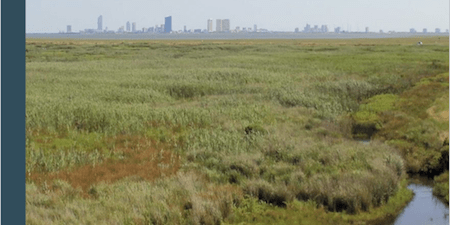Although coastal property owners and government agencies are increasingly turning to green solutions over grey ones to combat climate change-driven threats such as sea level rise and more frequent coastal storms, the hurdles to their implementation can be significant. A new report by the Mid-Atlantic Regional Council on the Ocean (MARCO) and the National Wildlife Federation (NWF) offers guidance for dealing with such barriers for those seeking to apply natural and nature-based features as waterfront defenses.
Natural and nature-based features (NNBF) are defined as those that have either evolved through natural processes, or have been engineered by humans to mimic natural functioning. Examples include reefs (e.g., coral and oyster), dunes, beaches, wetlands and maritime forests. They can also include a hybrid between manmade structures and nature-based solutions, such as living shorelines, drainage improvements, beach and dune restoration, and breakwaters.
The report, “Improved Use and Understanding of NNBF in the Mid-Atlantic,” describes the benefits to using NNBF and assesses impediments and offers solutions with specific application to the five-state region of New York, New Jersey, Delaware, Maryland and Virginia. Its findings are based on interviews with a diverse range of stakeholders in the region as well as input gathered in a pair of workshops held in New York and Virginia in 2016.
The feedback collected by the study team indicated that the most prominent barriers to implementing natural and nature-based features were related to permitting, project design, scaling up on private lands, and assessment and monitoring. The report explores next steps in overcoming a variety of these barriers and points to resources for increasing the implementation of natural and nature-based features including information on available design guidance.
“We know that nature-based solutions can and do work in the Mid-Atlantic because we’ve seen them put in place so effectively already,” said Kaity Goldsmith, Project Manager for MARCO. “It is important for practitioners to share these success stories not only among themselves, so they can learn from one another, but with the broader public, so people begin to consider natural defenses over traditional built ones that may not be effective in the long term.”
Natural features provide important benefits beyond climate adaptation, such as increasing property values, scenic enhancement, protecting water quality, recreation opportunities, and providing habitat for wildlife. However, the authors note that relatively little data quantifying the costs and benefits of implementing natural features is available – particularly compared to grey infrastructure – so a priority should be placed on gathering that information in the future.
“The more empirical data we can gather showing the economic effects of natural defenses, the more you’ll begin to see them chosen over projects that disrupt coastal ecosystems,” said Karl Schrass, Climate Adaptation and Resilience Manager for NWF.
Link to report on the MARCO website: https://www.midatlanticocean.org/wp-content/uploads/2017/03/Improved-Use-and-Understanding-of-NNBF-in-the-Mid-Atlantic.pdf
Link to NWF: http://www.nwf.org/
Share this:

